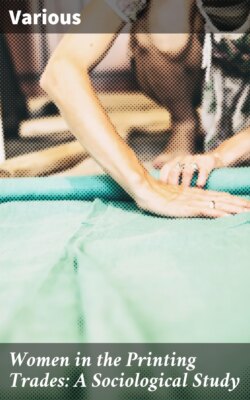Читать книгу Women in the Printing Trades: A Sociological Study - Various - Страница 6
На сайте Литреса книга снята с продажи.
Оглавление[3] Cf. pp. 76,77.
Typefounding.—Typefounding is a small, ancient and conservative trade into which women have only crept during the last few years. In London there are only about eight typefoundries proper, and in these labour is elaborately subdivided, every workman performing but one process. Recently, however, some large printing houses have begun to cast their own type, and in these the few men employed perform all the processes, or, to use their own term, "do the work through," thus, curiously enough, reverting to an earlier stage in the development of the trade.
Women are employed in the large foundries, where they perform certain subsidiary parts of the work. Each type when it comes from the machine wherein it has been cast has a little superfluous bit of thin metal, known as a "break" on its end or "foot." These bits are broken off by girls, the "foot" of the type being pressed against a table and the "break" snapped off. No great skill is required, but quickness only comes with practice. The type is also "set-up"—i.e., put in rows in a long stick or "galley"—by girls; here, again, nothing is needed beyond a certain manual dexterity. Sometimes another stage, "rubbing," intervenes between the "breaking" and the "setting-up." Rubbing is merely the smoothing off on a flat grindstone of any roughness that may be left by the machine round the "face" end of the type. In one case, in London, one or two women were once employed in rubbing, but none appear to be so engaged at present, and the newer appliances have made rubbing unnecessary. "Dressing," the final process through which the type passes, is said to be in some places performed by women; but no such instances have been found in London in the course of this investigation. The dresser receives the lines or sticks of type, polishes the sides, measures their length and breadth with a delicate spanner, "nicks" the foot of each type, and finally "picks over" the type—that is, scans the row of "faces" through a magnifying glass, and rejects any on which the letters are not absolutely truly placed.
One large London firm, employing many girls, has a different process. The types are cast in long lines and have to be divided, no breaking or setting-up being required. As one of the workers said, "This is not a trade; just any one can do it!"
Girls began to do "breaking" and "setting-up" in London about thirteen years ago. There were then but thirteen so employed. During the last few years their numbers have increased, and it is estimated that those now employed number from 100 to 150. One firm is known to employ fifty and another forty. They have superseded boys, and were mainly introduced because boys were difficult to get. The chances of rising being small for boys, they were disinclined to enter the trade. The chances for girls are nil, but this consideration does not weigh much with girls belonging to the class that supplies workers to typefounding. The female workers are all young, and at present no married women seem to be employed, a fact which may perhaps be due to the comparatively recent entrance of women into the trade.
The occupation has a special feature of unhealthiness—the danger of lead-poisoning; and the Factory Act, recognising this, prohibits women, young persons or children, from taking a meal upon the premises where typefounding is carried on. As in other lead industries, much depends on the care and cleanliness of the worker. To eat with hands lead-blackened by some hours of "breaking-off" is to run considerable risk of lead-poisoning. It is suggested that girls, being more fastidious than boys upon such points, may possibly suffer less frequently from the dangers involved in the industry of typefounding.
